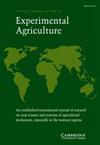Using manure for improving nitrogen fertilization and maize yield
IF 1.9
4区 农林科学
Q1 Agricultural and Biological Sciences
引用次数: 3
Abstract
Abstract Manure and chemical fertilizers have different effects on soil properties, the nitrogen cycle, and crop yield. This study aimed to investigate the effects of different fertilizer applications under the same N input on soil physicochemical properties and soil bacterial communities and to explain the contributions of soil properties to grain yield. Manure substitution of chemical fertilizer was conducted in leaching monitoring systems. The study began in 2009 and sampling was carried out in 2014 and 2016. Three fertilizer treatments with the same total N, P, and K application rates and one control treatment were designed as follows: (1) CK, without nitrogen fertilizer; (2) 100%U, whole nitrogen coming from urea; (3) 100%M, whole nitrogen coming from composted cattle manure; and (4) 50%U + 50%M, half nitrogen from composted cattle manure and half nitrogen from urea. Soil organic carbon (SOC) content was positively correlated with total N (TN), NO3−–N, and NH4+–N contents, the mean weight diameter of soil aggregates, and the Shannon diversity index of bacteria, whereas SOC content was not significantly correlated with grain yield. NO3−–N content was positively correlated with grain yield. Substituting half the amount of chemical fertilizer with manure as a nitrogen source improved soil stability, increased bacterial diversity, and enhanced nitrogen supply, while reducing nitrogen loss from ammonia volatilization and nitrogen leaching. Substituting half the amount of chemical fertilizer with manure as a nitrogen source was a more sustainable way to increase grain yield through a sustainable nitrate supply and to reduce N loss.利用粪肥提高氮肥和玉米产量
摘要肥料和化肥对土壤性质、氮循环和作物产量有不同的影响。本研究旨在研究在相同氮输入下不同施肥方式对土壤理化性质和土壤细菌群落的影响,并解释土壤性质对粮食产量的贡献。在浸出监测系统中进行了化肥的肥料替代。这项研究始于2009年,采样时间分别为2014年和2016年。设计了三个总氮、磷、钾施用量相同的肥料处理和一个对照处理:(1)CK,不施氮肥;(2) 100%U,全氮来自尿素;(3) 100%M,全氮来自堆肥牛粪;和(4)50%U+50%M,一半来自堆肥牛粪的氮和一半来自尿素的氮。土壤有机碳(SOC)含量与总氮(TN)、NO3-–N和NH4+–N含量、土壤团聚体平均粒径和细菌Shannon多样性指数呈正相关,而SOC含量与粮食产量无显著相关性。NO3-氮含量与籽粒产量呈正相关。用粪肥替代一半量的化肥作为氮源,提高了土壤稳定性,增加了细菌多样性,增加了氮供应,同时减少了氨挥发和氮浸出造成的氮损失。用粪肥替代一半的化肥作为氮源,是通过可持续的硝酸盐供应提高粮食产量和减少氮损失的一种更可持续的方式。
本文章由计算机程序翻译,如有差异,请以英文原文为准。
求助全文
约1分钟内获得全文
求助全文
来源期刊

Experimental Agriculture
农林科学-农艺学
CiteScore
2.50
自引率
6.20%
发文量
29
审稿时长
24 months
期刊介绍:
With a focus on the tropical and sub-tropical regions of the world, Experimental Agriculture publishes the results of original research on field, plantation and herbage crops grown for food or feed, or for industrial purposes, and on farming systems, including livestock and people. It reports experimental work designed to explain how crops respond to the environment in biological and physical terms, and on the social and economic issues that may influence the uptake of the results of research by policy makers and farmers, including the role of institutions and partnerships in delivering impact. The journal also publishes accounts and critical discussions of new quantitative and qualitative methods in agricultural and ecosystems research, and of contemporary issues arising in countries where agricultural production needs to develop rapidly. There is a regular book review section and occasional, often invited, reviews of research.
 求助内容:
求助内容: 应助结果提醒方式:
应助结果提醒方式:


